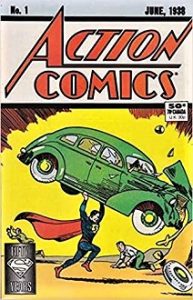
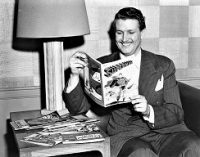 The Adventures of Superman (1940-1951) aired “The Mystery of the Flying Monster” on March 7, 1949 as the 13th episode of the 60 comprising its 1949 season (all of which were of the half hour variety as opposed to the many multi-part, 15-minute serials that ran through most of the 1940s). The Superman character, created by Jerry Siegel and Joe Shuster, first appeared in Action Comics #1, dated June 1938. That superhero strip in the comic was one of several strips in that now famous first issue, but turned out to be popular enough that a newspaper comic strip debuted in 1939. It also proved immensely popular, popular enough that a stand alone comic book was spun off and added to the ever-growing franchise, with the now iconic title of Superman #1, with a cover date of Summer 1939 (cover below left).
The Adventures of Superman (1940-1951) aired “The Mystery of the Flying Monster” on March 7, 1949 as the 13th episode of the 60 comprising its 1949 season (all of which were of the half hour variety as opposed to the many multi-part, 15-minute serials that ran through most of the 1940s). The Superman character, created by Jerry Siegel and Joe Shuster, first appeared in Action Comics #1, dated June 1938. That superhero strip in the comic was one of several strips in that now famous first issue, but turned out to be popular enough that a newspaper comic strip debuted in 1939. It also proved immensely popular, popular enough that a stand alone comic book was spun off and added to the ever-growing franchise, with the now iconic title of Superman #1, with a cover date of Summer 1939 (cover below left).
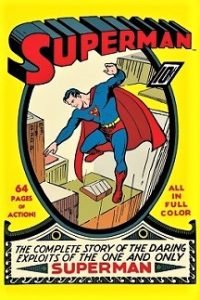 But the comic strip and magazine were only the beginning for the Man of Steel. Things were moving quickly, and as Wikipedia explains: “The serial came to radio as a syndicated show on New York City’s WOR on February 12, 1940. On Mutual, it was broadcast from August 31, 1942, to February 4, 1949, as a 15-minute serial, running three or, usually, five times a week. From February 7 to June 24, 1949, it ran as a thrice-weekly half-hour show. The series shifted to ABC Saturday evenings on October 29, 1949, and then returned to afternoons twice a week on June 5, 1950, continuing on ABC until March 1, 1951. In all, 2,088 original episodes of The Adventures of Superman aired on American radio.” Wikipedia also notes that many of the elements that have become staples of Superman’s fictional world were first introduced in the radio show, among them kryptonite, Daily Planet editor Perry White, copy boy (later cub reporter) Jimmy Olsen, and police inspector Bill Henderson. Also worthy of mention is the first meeting between Superman and Batman (and Robin) which took place in the March 2, 1945 episode.
But the comic strip and magazine were only the beginning for the Man of Steel. Things were moving quickly, and as Wikipedia explains: “The serial came to radio as a syndicated show on New York City’s WOR on February 12, 1940. On Mutual, it was broadcast from August 31, 1942, to February 4, 1949, as a 15-minute serial, running three or, usually, five times a week. From February 7 to June 24, 1949, it ran as a thrice-weekly half-hour show. The series shifted to ABC Saturday evenings on October 29, 1949, and then returned to afternoons twice a week on June 5, 1950, continuing on ABC until March 1, 1951. In all, 2,088 original episodes of The Adventures of Superman aired on American radio.” Wikipedia also notes that many of the elements that have become staples of Superman’s fictional world were first introduced in the radio show, among them kryptonite, Daily Planet editor Perry White, copy boy (later cub reporter) Jimmy Olsen, and police inspector Bill Henderson. Also worthy of mention is the first meeting between Superman and Batman (and Robin) which took place in the March 2, 1945 episode.
Bud Collyer (1908-1969, photo top right)) was the voice of Clark Kent and Superman on radio, lowering his voice slightly when speaking as the Man of Steel. He is arguably best known, however, as the host of the popular television game shows of the 1950s, Beat the Clock and To Tell the Truth.
Joan Alexander (1915-2009, birth name Louise Abrass) played the spunky Lois Lane character for more than one thousand episodes of the program’s 11-year run.
From 1940-47 Jack Kelk (1923-2002) would play Jimmy Olsen, and from 1948-1950 (and in this episode) it was Jack Grimes (1926-2009) who would play Jimmy Olsen. An interesting bit of trivia concerning Grimes is that though he was an old man of 22 when he began playing Jimmy Olsen, by the age of 12 he was acting in 35-40 radio shows a week. Grimes also worked in film and television in later years. A film of note in which he appeared was 1945’s noir crime film Lady on a Train (starring Deanna Durbin and Ralph Bellamy), based on the Leslie Charteris story. His television work included roles in Tom Corbett, Space Cadet, Maude, and All in the Family.
(Left: Joan Alexander – Center: Jack Kelk – Right: Jack Grimes)
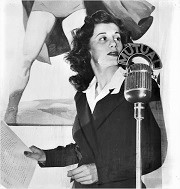
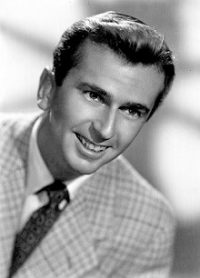
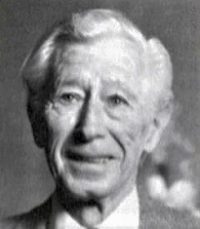
“The Mystery of the Flying Monster” begins with a newspaper ad from an inventor seeking a young man to be an assistant in a scientific experiment. The young man will receive small pay and must be “absolutely fearless.” Being the impetuous and naive soul that he is, Jimmy Olsen takes the bait and answers the ad. Soon enough we learn that there is more to it than revealed in the ad and Jimmy finds himself in a real pickle and goes missing, leaving Perry White, Clark, and Lois to find him, though their friend’s fate looks dark when word of an explosion at the inventor’s laboratory tops the news. Suffice it to say that young Olsen’s misadventure turns on something given the monicker of a “gravity activator.” To learn what this strange substance is and what it leads to, simply lean back and enjoy the rollicking tale of “The Mystery of the Flying Monster.”
Play Time: 29:34
{The neighborhood gang loved their superheroes, especially Superman, as much as they loved their SF and adventure pulps, so it was no wonder they found themselves gathered at the nearby newsstand after listening to this episode of The Adventures of Superman the day before, to make sure they hadn’t missed any issues of their favorites before they were sold out. Famous Fantastic Mysteries (1939-53) featured SF and Fantasy classics, many published before there were any magazines specifically devoted to these genres. It was a bi-monthly in 1949. Jungle Stories (1938-54) played well into the sense of adventure and danger upon which many youngsters thrived. It was a quarterly in 1949. Doc Savage (1933-49) was an old favorite and Doc was considered a superhero in his own right. Though the magazine enjoyed a solid 16-year run, all good things—including pulp magazines—must eventually come to an end. Doc Savage would cease publication with its next issue, dated Summer 1949. It was a quarterly when it closed shop.]
[Left: Famous Fantastic Mysteries, April 1949 – Center: Jungle Stories, Spring 1949 – Right: Doc Savage, Spring 1949]
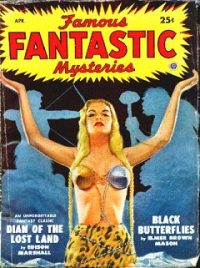
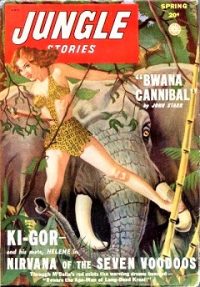
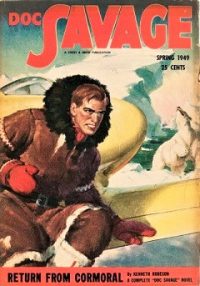
To view the entire list of weekly Old Time Radio episodes at Tangent Online, click here.